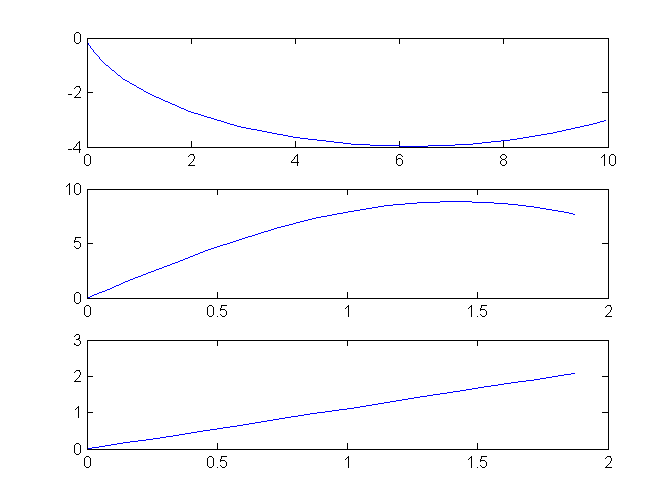PROPT The Brachistochrone Problem
From TomWiki
Jump to navigationJump to search
|
This page is part of the PROPT Manual. See PROPT Manual. |
This problem was formulated by Johann Bernoulli, in Acta Eruditorum, June 1696
Problem description
"Given two points A and B in a vertical plane, what is the curve traced out by a point acted on only by gravity, which starts at A and reaches B in the shortest time."
In this example, we solve the problem numerically for A = (0,0) and B = (10,-3), and an initial speed of zero.
The mechanical system is modelled as follows:
where (x,y) is the coordinates of the point, v is the velocity, and theta is the angle between the direction of movement and the vertical.
% Copyright (c) 2007-2009 by Tomlab Optimization Inc.Problem setup
toms t
toms t_f
p = tomPhase('p', t, 0, t_f, 20);
setPhase(p);
tomStates x y v
tomControls theta
% Initial guess
% Note: The guess for t_f must appear in the list before expression involving t.
x0 = {t_f == 10
icollocate({
v == t
x == v*t/2
y == -1
})
collocate(theta==0.1)};
% Box constraints
cbox = {0.1 <= t_f <= 100
0 <= icollocate(v)
0 <= collocate(theta) <= pi};
% Boundary constraints
cbnd = {initial({x == 0; y == 0; v == 0})
final({x == 10; y == -3})};
% ODEs and path constraints
g = 9.81;
ceq = collocate({
dot(x) == v.*sin(theta)
dot(y) == -v.*cos(theta)
dot(v) == g*cos(theta)});
% Objective
objective = t_f;Solve the problem
options = struct;
options.name = 'Brachistochrone';
solution = ezsolve(objective, {cbox, cbnd, ceq}, x0, options);
x = subs(collocate(x),solution);
y = subs(collocate(y),solution);
v = subs(collocate(v),solution);
theta = subs(collocate(theta),solution);
t = subs(collocate(t),solution);Problem type appears to be: lpcon
Time for symbolic processing: 0.1296 seconds
Starting numeric solver
===== * * * =================================================================== * * *
TOMLAB - TOMLAB Development license 999007. Valid to 2011-12-31
=====================================================================================
Problem: --- 1: Brachistochrone f_k 1.878940329113842700
sum(|constr|) 0.000000174716299412
f(x_k) + sum(|constr|) 1.878940503830142100
f(x_0) 10.000000000000000000
Solver: snopt. EXIT=0. INFORM=1.
SNOPT 7.2-5 NLP code
Optimality conditions satisfied
FuncEv 1 ConstrEv 834 ConJacEv 834 Iter 224 MinorIter 826
CPU time: 0.436803 sec. Elapsed time: 0.446000 sec.
Plot the result
To obtain the brachistochrone curve, we plot y versus x.
subplot(3,1,1)
plot(x, y);
subplot(3,1,2)
plot(t, v);
% We can also plot theta vs. t.
subplot(3,1,3)
plot(t, theta)


